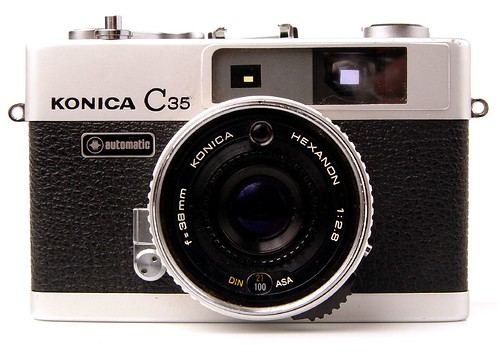Difference between revisions of "Rangefinder camera"
Rebollo fr (talk | contribs) (removed purely commercial link, with no actual information on the cameras) |
(re-linked photo, ->CW pool; larger & explanatory caption) |
||
| Line 1: | Line 1: | ||
| − | '' | + | {{glossary}} |
| + | {{Flickr_image | ||
| + | |image_source= http://www.flickr.com/photos/martintaylor/47308060/in/pool-camerawiki | ||
| + | |image= http://static.flickr.com/31/47308060_8c9e30de76.jpg | ||
| + | |image_align= right | ||
| + | |image_text=Second, smaller window for rangefinder-focusing spot | ||
| + | |image_by= Martin Taylor | ||
| + | |image_rights= non-commercial | ||
| + | }} | ||
| + | ''For a list of rangefinder cameras, see the [[:Category: Rangefinder]].'' | ||
| − | |||
'''Rangefinder cameras''' are those that focus using some sort of coincident-viewing distance-determination mechanism, called a [[rangefinder (device)|rangefinder]]. The most common form, as used in cameras like the [[Leica]] and other classic small [[35mm]] cameras, is to use a prism and mirror arrangement between two viewing windows. Small adjustments in the angles of the prisms will align two superimposed images -- when the images are aligned the distance can be determined accurately by a simple mechanical cam. With a large enough [[rangefinder base]], this type of rangefinder can offer extremely accurate focusing. Such rangefinders have been used in 35mm cameras, such as those made by Leica, [[Canon]], [[Nikon]], and others for many years, and also in larger-format cameras such as medium format folding cameras or rigid cameras like the [[Mamiya 7]], and even some early [[Polaroid]] cameras. | '''Rangefinder cameras''' are those that focus using some sort of coincident-viewing distance-determination mechanism, called a [[rangefinder (device)|rangefinder]]. The most common form, as used in cameras like the [[Leica]] and other classic small [[35mm]] cameras, is to use a prism and mirror arrangement between two viewing windows. Small adjustments in the angles of the prisms will align two superimposed images -- when the images are aligned the distance can be determined accurately by a simple mechanical cam. With a large enough [[rangefinder base]], this type of rangefinder can offer extremely accurate focusing. Such rangefinders have been used in 35mm cameras, such as those made by Leica, [[Canon]], [[Nikon]], and others for many years, and also in larger-format cameras such as medium format folding cameras or rigid cameras like the [[Mamiya 7]], and even some early [[Polaroid]] cameras. | ||
| Line 33: | Line 41: | ||
[[Category: Rangefinder|*]] | [[Category: Rangefinder|*]] | ||
[[Category: Camera architecture]] | [[Category: Camera architecture]] | ||
| − | |||
Revision as of 17:19, 3 May 2011

|
| Second, smaller window for rangefinder-focusing spot image by Martin Taylor (Image rights) |
For a list of rangefinder cameras, see the Category: Rangefinder.
Rangefinder cameras are those that focus using some sort of coincident-viewing distance-determination mechanism, called a rangefinder. The most common form, as used in cameras like the Leica and other classic small 35mm cameras, is to use a prism and mirror arrangement between two viewing windows. Small adjustments in the angles of the prisms will align two superimposed images -- when the images are aligned the distance can be determined accurately by a simple mechanical cam. With a large enough rangefinder base, this type of rangefinder can offer extremely accurate focusing. Such rangefinders have been used in 35mm cameras, such as those made by Leica, Canon, Nikon, and others for many years, and also in larger-format cameras such as medium format folding cameras or rigid cameras like the Mamiya 7, and even some early Polaroid cameras.
Other styles of rangefinder do exist, such as the electronic variety found in the Contax G1 and G2 cameras. In general, "rangefinder" focusing is often used to describe any focusing mechanism that doesn't view directly through the taking lens (or an identical copy of that lens, as in Twin Lens Reflex cameras).
Contents
Pros
- Very accurate focusing.
- Easy to focus in low light.
- No mirror slap.
- Relatively quiet operation.
- Short shutter lag.
- No viewfinder blackout.
Cons
- Parallax problems with nearby subjects (though higher-end rangefinders usually have parallax correction built in).
- Accessory viewfinders are required for non-normal focal lengths.
- Rudimentary depth of field control if any.
- Nearly impossible to use a polarizer.
See Also
Links
- How Rangefinders Work
- Photozone's SLR vs Rangefinder comparison
- Steve Gandy's explanation of 35mm rangefinders and viewfinders at CameraQuest
- Lionel's rangefinder camera collection at 35mm-compact
- The Fukucame Rangefinder website, including interesting chronology pages